The Mathematics Department at GIIS Tokyo Campus successfully conducted various wonderful Math activities for its grade section for an entire week. All the students participated in the activities with a lot of fervour. Such activities provide opportunity for building self-confidence and help in developing a positive attitude toward mathematics.
The tiny tots of Class 1A had a lot of fun doing the place value activity using stickers and toothpicks, i.e., recognising tens and ones in a given number. While as the Class 2 students enjoyed doing alphabet multiplication using the theme of autumn. Chopsticks were effectively used by Grade 3 students to understand the concept of multiplication tables.
Maths teachers at GIIS Tokyo said, "Every problem has a gift for us- the joy of discovering a solution. There is no one way to solve a problem". This thinking was amply demonstrated by the students of various classes during their math activity.
Students of Class 1B were trained to add 2 numbers and find the answer. However, when they were given the answers and asked to frame a question, they put on their thinking hats and came up with various solutions.
Addition Facts: Students were divided into smaller groups. They were given coloured dot stickers and a solution. Students had to think of various ways to find the solution. For example, if the solution is 10, the students thought of different addition facts like, 1+9; 2+8; 0+10; 3+7 etc.
Each group was given a number and they had to find various addition facts.
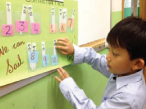 Subtraction Facts: Similarly the students discovered various subtraction facts. One solution can have different subtraction facts. This activity of picking up a stick with a subtraction fact and putting it in the correct slot generated lot of enthusiasm. Subtraction Facts: Similarly the students discovered various subtraction facts. One solution can have different subtraction facts. This activity of picking up a stick with a subtraction fact and putting it in the correct slot generated lot of enthusiasm.
The teachers also reiterate that simple changes in our daily habits and ways of thinking can stimulate lateral thinking. 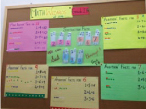 This can boost creative thinking and induce imaginative problem solving methods. Class 4B students were given the ancient Chinese puzzle, Tangrams, consisting of 7 pieces to come up with their creativity. The 7 geometrical pieces of 5 triangles, 1 square and 1 parallelogram can be put together in innumerable ways to make different shapes. This excited the students to think differently and come up with interesting shapes like rabbit, candle rocket, etc. This can boost creative thinking and induce imaginative problem solving methods. Class 4B students were given the ancient Chinese puzzle, Tangrams, consisting of 7 pieces to come up with their creativity. The 7 geometrical pieces of 5 triangles, 1 square and 1 parallelogram can be put together in innumerable ways to make different shapes. This excited the students to think differently and come up with interesting shapes like rabbit, candle rocket, etc.
Tangrams stimulate spatial understanding of abstract mathematical concepts.
For example, in the puzzle,
The area of the large triangle = twice the area of the medium triangle.
The area of the medium triangle = twice the area of small triangle etc.
This is not only fun for children but this kind of thinking triggers innovation.
Here are some snap shots of their creativity:
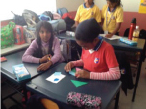 For Class 4A, the concept of "Factor trees" was represented by students as part of the mathematics activity. The students worked in teams and used numerous creative ways to depict factor trees. The students came up with various colourful and beautiful ways to represent factor trees. This activity helped students to use out of the box thinking to represent factor trees and thus helped them to understand the concept in a better way. For Class 4A, the concept of "Factor trees" was represented by students as part of the mathematics activity. The students worked in teams and used numerous creative ways to depict factor trees. The students came up with various colourful and beautiful ways to represent factor trees. This activity helped students to use out of the box thinking to represent factor trees and thus helped them to understand the concept in a better way.
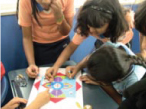 For Class 5, the concept of symmetry was analysed by the students as part of their mathematics activity. The students worked in teams to make symmetrical figures and came up with various innovative ways. A completely colourful and creative way of representation of symmetrical figures was used by students that left everyone spellbound. For Class 5, the concept of symmetry was analysed by the students as part of their mathematics activity. The students worked in teams to make symmetrical figures and came up with various innovative ways. A completely colourful and creative way of representation of symmetrical figures was used by students that left everyone spellbound.
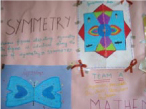 According to the Head of Department, Mathematics, Ms. Manjinder Nagra, "Mathematics can be a difficult subject for some students. Complex concepts, countless mathematical laws and time consuming problems make mathematic one of the most challenging subjects for students of all ages. There are many different ways for students to learn and study mathematical concepts. Using math-based games or themed group activities are just a few methods that have proved to be very successful with young learners." She further says, "Learning mathematics does not have to be boring; it can be active, engaging and fun." According to the Head of Department, Mathematics, Ms. Manjinder Nagra, "Mathematics can be a difficult subject for some students. Complex concepts, countless mathematical laws and time consuming problems make mathematic one of the most challenging subjects for students of all ages. There are many different ways for students to learn and study mathematical concepts. Using math-based games or themed group activities are just a few methods that have proved to be very successful with young learners." She further says, "Learning mathematics does not have to be boring; it can be active, engaging and fun."
Her Class 6 students, she says, ask one question most frequently. "Why do we need to study Geometry?" Therefore, the topic chosen for the group activity for Class 6 students was "Geometry Around Us". The students, with the help of the teacher, researched and came out with brilliant ideas. Each student selected a topic ranging from "Usage of geometry in robotics, in cars, in buildings, in interior designing etc.
Another very frequently asked question by the students across all classes is, "Where do we use mathematics when we grow up?". Grade 8 students made a joint effort of finding different professions which the students can opt for if they continue to study maths. Every student worked on a profession of his/her choice and presented it in a very innovative way. The various professions chosen by the students were as follows: actuary, analyst, cryptanalyst, climatologist, teacher, etc.
Students of Classes 8, 9 and 10 showed a lot of enthusiasm in learning about Leonardo Pisano Bigollo or simply Fibonacci, who was an Italian mathematician, considered by some to be the most talented western mathematician of the middle ages.
|
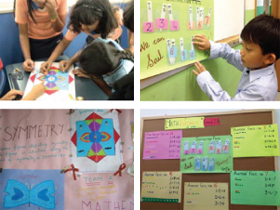



Comments ({{totalComments}})
Login to post a comment...
{{comments.CommentText}}